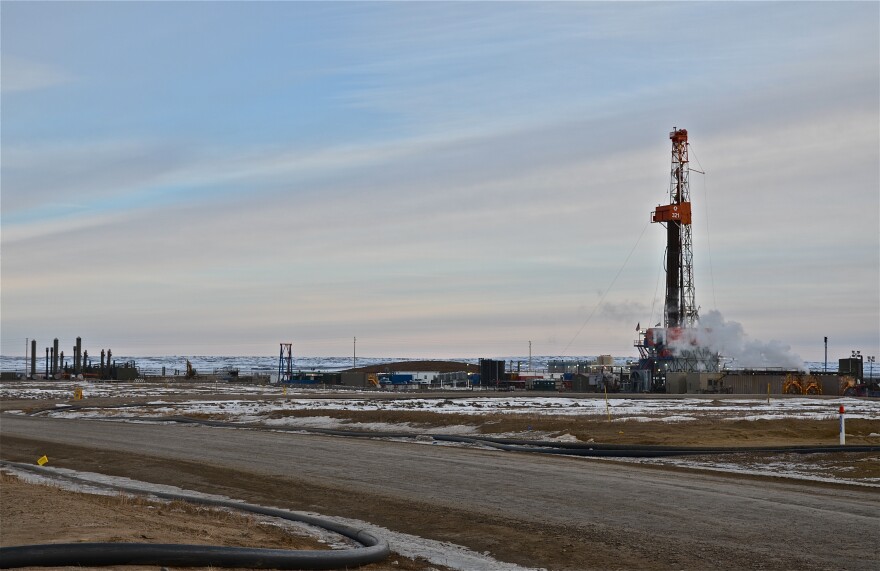Several years ago, there were days when air pollution in Pinedale was worse than in Los Angeles. Residents complained of respiratory problems, and visits to local medical clinics increased. In 2012, the Environmental Protection Agency said the area was violating federal air quality standards, and gave Wyoming three years to fix the problem. Since then, air quality has been better. But as Wyoming Public Radio’s Willow Belden reports, nobody knows whether the problem is really fixed, and some worry that the state is not doing enough to prevent similar problems from happening elsewhere.
WILLOW BELDEN: The pollution in question is called ground-level ozone. It forms when different sorts of emissions – in this case, from energy development – react with each other, under certain weather conditions.
To address the problem, the state started requiring new production facilities to have special technology that cuts down on emissions. Some operators also have taken voluntary steps to pollute less, for example by retrofitting older equipment. Steve Dietrich with the Wyoming Department of Environmental Quality says that’s helped.
STEVE DIETRICH: This winter ozone season, there have not been any excedences of the eight-hour ozone standard.
BELDEN: In other words, there haven’t been any days where ozone levels went above the legal limit. The same was true last winter.
ROB FIELD: I think it’s good news.
BELDEN: That’s Rob Field. He’s an atmospheric scientist at UW, and he’s been studying ozone in Sublette County for several years. He says recently, he’s been detecting much lower levels of certain types of pollutants in the air. That’s partly because of DEQ’s new rules and partly because there’s simply less new development in the area.
FIELD: So while we still have a lot of oil and natural gas produced, we see less drilling rigs. … Back in 2011, we had 15 or maybe more drill rigs. This last year, maybe down to five.
BELDEN: And that means a reduction in emissions. But does it mean the ozone problem is fixed?
FIELD: I don’t think we can say that yet.
BELDEN: That’s because emissions are only part of the puzzle. A lot also depends on weather. Several years ago, when ozone levels were high, nighttime temperatures were very cold. That created conditions that trapped the pollution in the area, which contributed to higher ozone levels. Recently, it’s been warmer.
FIELD: Would I expect there to be ozone next year? If we see these meteorological conditions, and we continue to see less activity and good emission control, maybe we won’t see ozone next year. But again, it’s a guess at this point. We just have to keep measuring and keep watching the system to see how it changes in the future.
BELDEN: Scientists still don’t have an exact recipe of ingredients and weather conditions that have to be come together in order for high levels of ozone to form. Because of that uncertainty, the Department of Environmental Quality is planning to do even more to curb emissions. They’re drafting rules that would require greener retrofits for old energy facilities, in other words, facilities that were put in when the rules were more lax.
Bruce Pendery with the Wyoming Outdoor Council says that’s good, but he wants to see the state prevent, rather than just respond to, ozone pollution. The new rules will only apply in the Sublette County area, where ozone problems have been documented. Energy equipment elsewhere in the state will still be allowed to pollute just as much as in the past.
BRUCE PENDERY: They should consider extending regulations to more of a state-wide basis. … If oil and gas could cause air pollution problems in the Pinedale area when they were having a boom over there, maybe we’re going to see the same thing in other places if we’re not out in front of it a little bit.
BELDEN: But Steve Dietrich with DEQ says there are no plans to impose Pinedale-style regulations on the whole state any time soon. That would mean an extra cost for operators.
DIETRICH: There may not actually be a problem in other parts of the state. So to put the industry and put everything at risk by ratcheting down to the nth degree, may not make good economic sense to do that.
BELDEN: Dietrich says if they detect high levels of pollution elsewhere, they’ll deal with the problem then. As for Pinedale, they’ll keep monitoring air quality, and if ozone levels stay low next winter, EPA could consider lifting the nonattainment designation. For Wyoming Public Radio, I’m Willow Belden.






